|
The
Piquant Universum of the
Dutch Impressionistic Painter Harry Maas.
Youth
Harry Maas, born July 23,
1906 in Nederweert (the South of the Netherlands), was a son of
the teacher Herman H.J. Maas, who was also a writer of regional
novels like Verstooteling (1907) and Goud van de Peel
. He was also called the ‘Brabantse Zola’ because his novels
dealt with the social abuses in this particular region. His
militant and critical attitude towards educational matters and
social issues as expressed in his novels were the reason he became
a pariah within the Catholic community and also had major
implications on his career. Therefore the family Maas
consecutively moved to Venlo (1911), Roermond (1912-1923),
Doetinchem (1923-1925), Nijmegen (1925-1931) and finally Eindhoven
(July 1931).
In Roermond Harry visits the H.B.S.
where he gets drawing lessons from M.G. Hölscher (1907-1940) and
in Nijmegen he gets painting lessons from Anton Kloosterhuis
(1888-1959). Due to the contrariness of father Maas the family is
in a difficult situation. Mother Maas was taken to a mental
hospital in Vught where she dies in 1948. The eldest son Herman
Jr., a graduate lawyer, without a steady job dies in 1940 of a
skin disease. The youngest descendant Willy was hospitalized in a
sanatorium due to an unstable mental state. Although Harry stays
with his father they barely communicate because of their
contradicting characters.
Exhibitions
The family circumstances must have
had a deciding effect on the life of Harry Maas. In Eindhoven
Harry seeks contact with “de Eindhovense Schetsclub (sketch
club)” that was established in 1929 by Jan and André van
Bergeyk. Soon he became the driving force of this club where
professionals and amateurs meet during while drawing clothed and
nude figures. On their first exhibition in “Kunstzaal Verheugen”
(1932) his work was prominently present. Maas also joins “De
Zuid-Nederlandse Onafhankelijken”, an association of artists
founded by Johannes Nicolaas in 1934. At their first exhibition in
1935 in the old town hall he is “one of the most notable
appearances”. In 1937 he has a solo show (the only one in his
life) at the art room Verheugen. Together with some other artists
from Eindhoven he becomes a member of the “Bredasche Kunstkring
(art circle)” with whom he exhibits several times during the
early forties. After the Second World War Maas, as a member of the
art circle De Kempen and the “Eindhovense Schetsclub”, he
participates in his last visual arts exhibitions.
After this Maas stops exhibiting
because he claims that he has no more work in stock. A lot of his
work he sells through art dealers Roelofs in Amsterdam and Beckers
in Eindhoven. But a more obvious reason for his aversion could be
the different views on art that emerged at that period. Also in
reviews on his work there was more criticism, substantiated by the
fact that Maas had lost one eye during the bombing on December 6,
1942 which would have had a negative impact on his artistic
achievements.
Later Years
After the death of his father Harry
Maas moves consecutively to the Akkerstraat 23, the Ooistraat 25
and circa 1970 De Kleine Berg 79. Although “de Eindhovense
Schetsclub” went defunct in 1969 he continues his weekly drawing
sessions with his friends. In 1974 he marries the younger naive
painter Netty Michels (1919-1995), who has been coming to him for
years. On June 4, 1982 Maas dies in Eindhoven and is buried on the
“Catherinakerkhof”.
His Work
In the thirties Harry Maas gets
fame as draughtsman and painter of portraits and figure paintings.
In addition he makes linocuts and starts etching. His preferred
model, and his great love, is Jeanne van den Bogaard (1913-2003).
The love is not mutual but they always remain friends as well as
with her twin sister Mary van den Bogaard. During the war period
Maas brushed many still lifes and around 1950, as a result of many
trips to England and Paris, he starts painting cityscapes and
landscapes. His passion for steam locomotives and trams get a
permanent place in his oeuvre, sometimes supplemented with
fashionably dressed, graceful (school) girls.
Nudes
He painted in a slightly
French-oriented, impressionistic style. His smooth touch and its
cheerful, bright colors radiate the joy of painting.The female,
half dressed or spicy nude, is a leading thread through his work.
The numerous, detailed nudes portrayed in oil, watercolor, black
or red chalk and quick sketches have given Harry Maas his
reputation. At that time this topic was experienced as ‘on the
edge’ but nowadays these paintings give a nice image of the
time.
|
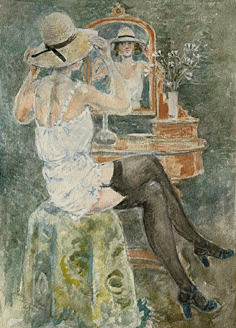
|
Girl
With Hat In Front Of A Mirror.
Aquarel on paper. Size: 19 2/3” X 14” inches.
Date: 1950. Signed: H. Maas 1950 ( below left
)
hm1. For Sale
€
1150,-
|
|
>
Click on
the Photo.
|
|
|
|
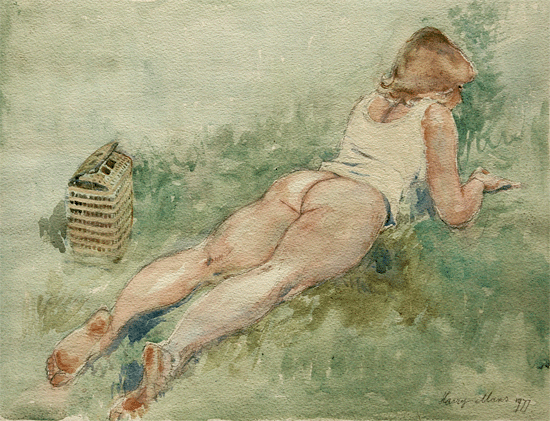
|
|
>
Click on
the Photo.
|
|
Semi-Nude Girl Laying In The Grass.
Aquarel on paper. Size:
16 1/6” X 12 1/5” inches. Date: 1977. Signed: H. Maas 1977 (
below right )
hm2.
For Sale
€
850,-
|
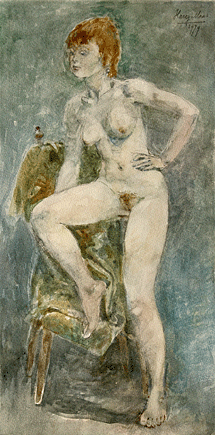
|
Red-Haired Girl Posing Near a Chair.
Aquarel on paper. Size: 10
1/2” X 18 3/4” inches.
Date: 1979. Signed: H. Maas 1979 ( upper right )
hm3. For Sale
€
850,-
|
|
>
Click on
the Photo.
|
|
|
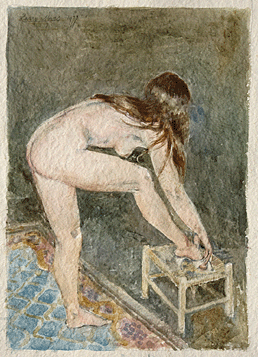
|
Nude Girl With Her Shoe on a Stool;
Aquarel on paper.
Size: 11 3/4” X 15 3/4” inches.
Date: 1977. Signed: H. Maas
1977 ( upper left )
hm4. For Sale
€
850,-
|
|
>
Click on
the Photo.
|
|
|
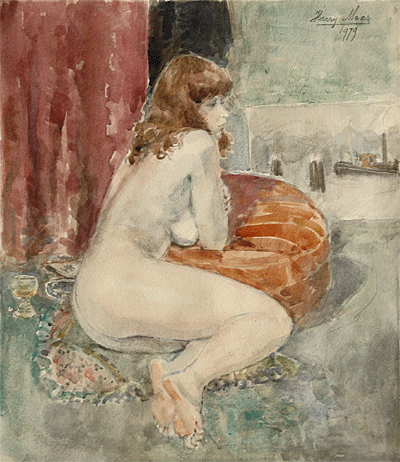
|
|
>
Click on
the Photo.
|
|
Nude Girl Posing on a Pouffe..
Aquarel on paper. Size: 11 3/4 X 15
3/4” inches. Date: 1979. Signed: H. Maas ( upper right )
hm5.
For
Sale €
850,-
|
|
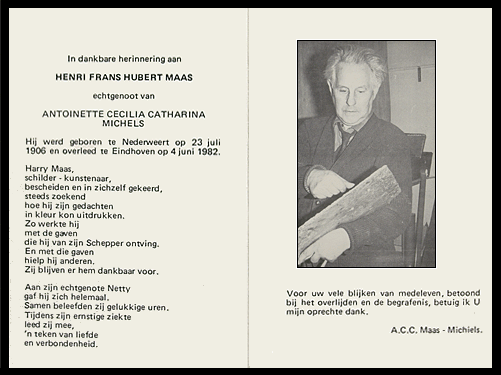
|
|
| Catholic
prayercard published shortly after Maas' death. |
|